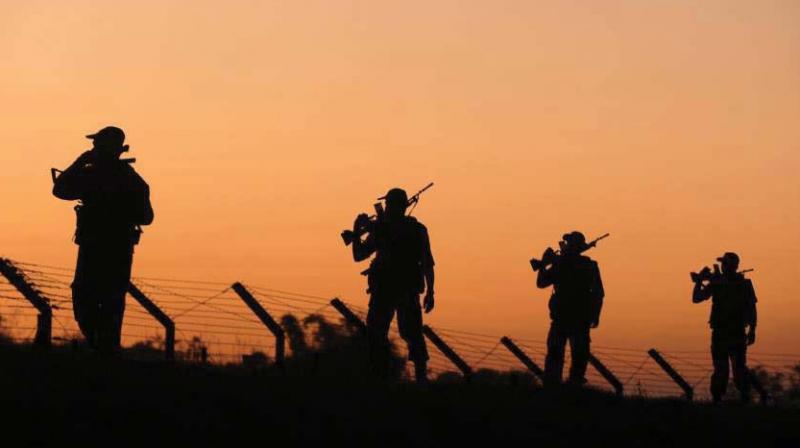Whose Army is it anyway?

The tone, tenor and phraseology of the official “voice” of the armed forces across both sides of the Line of Control (LoC) is a study in contrast. The content of the Indian Army’s official “ADGPI” Twitter handle is measured, restrained and within the iron-clad banalities of the Army’s functional contours, while the text and import of the Pakistani Army’s official Twitter handle, “ISPR Official”, is unequivocally expansive, political and suggestive beyond the military domain. So the first visit to the Northern Command after assuming responsibility as the Indian COAS got covered as, “Gen Bipin Rawat #COAS on his way to the #Northern Command. To review security, op preparedness & interact with troops & Cdrs dply in fwd areas”. A similar visit by the Pakistani COAS to a forward area was tweeted as, “LoC Visit. Army will protect people of Pakistan & J&K. Our solidarity with people of Indian-occupied Kashmir for right to self determination”. In Pakistan, the political angularity and overspill was unmistakable. Today, the Pakistani Army literally defines the scope for policy formulation for the executive and has often been called the “Army Inc.”, owing to a thriving commercial infrastructure that takes care of the institution and its personnel, both inside and outside of the uniform. As the saying goes, India has an Army, while the Pakistani Army has a country.
India is “coup proofed” owing to the genealogical beneficence of inheriting strong political infrastructure during Partition, while Pakistan inherited a chaotic and nascent political instinct. In Pakistan, the generals have ruled officially for 35 out of its 70 years of independence, while the balance of the 35 years has seen the Rawalpindi General Headquarters pull the strings in Islamabad from behind the scene. India is different, as no political party made a cause with the military till very recently (Lal Bahadur Shastri’s, “Jai Jawan, Jai Kisan”, notwithstanding). Post-Independence, as economic survival issues ebbed, socialistic dreams drowned and the opening of the economy ushered in “Emerging India”. The still-fractured and deeply polarised society sought a rallying cause that could encapsulate quasi-majoritarism under the garb of hyper-nationalism, and herein the political appeal of appropriating the Army became an irresistible way to establish “nationalistic” credentials for political parties. The 2014 general elections witnessed unprecedented images of invoking the “soldier” as part of political muscularity, decisiveness and patriotism. Though post-elections, the military continued taking in the multiple allusions and failed promises on its chin (e.g. OROP, Seventh Pay Commission etc.), the institution has remained steadfast, in-line, ramrod straight and absolutely quiet as to who exactly owns it. It rightfully swears to the Constitution of India and not to any political party, person or religion — though this has not stopped the barrage of abusers who invoke the “soldier” to peddle their own political wares.
Does the Indian Army belong to Raj Thackeray who offers Rs 5 crore to Gurmehar Kaur, Kanhaiya Kumar, to gau rakshaks or even Umar Khalid? The simple answer is, “all of the above”. Recent times have seen the armed forces getting contextualised to any politico-societal issue — from AFSPA, surgical strikes, banning Pakistani artistes in India, to even demonetisation. Alluding to the armed forces and the “soldier” is the leitmotif of the nationalist to the anti-nationalist (the terms getting constantly redefined by the usage and the circumstances of applicability). All the while, the Indian armed forces officially choose to keep mum, as it has for the past 70 years. The vicarious voice in the form of the veterans, which emerged powerfully in the run-up to the OROP agitation, has sadly but successfully been divided with the old fogeys, echoing various party lines with typical military bluster. Many have morphed into “newsroom warriors”, in tilted regimental hats, affording uncontestable patriotism to political party flags. Yet, despite multiple provocations, interferences and allusions, the armed forces have not chosen one Indian over the other. The recent Assembly elections saw the tragic misuse of the imagery of the Indian “soldier” and the “surgical strikes”, contextualised with equally martial images of political leaders with arms raised and clenched fists — all to score political brownie-points, as if the Indian soldier were the exclusive preserve of such parties or individuals.
The Indian soldier’s revered imagery has also emerged as an invaluable tool of political deflection and plausible defence, e.g. the woes of demonetisation were brushed aside by rote: “If our soldiers can stand for hours every day guarding our borders…” The inherent danger of such a casual invocation to the “Indian soldier” is the willy-nilly invitation to enforce a political flavour to an institution that is proudly apolitical. The last and only successful bastion of “inclusivity”, “secularism” and region-agnosticism runs the risk of prefixing “pseudo” to most adjectives, which defines and exemplifies their conduct. Similar contradictions emerged in the US recently, where having milked the latent fears of the common man and hurrahed the “Oorah” of the veterans, the US President let one candid one slip-in when he said, “We never win, and we don’t fight to win”. He riled the veterans and, by default, the standing forces, about his insincerity towards the armed forces. Political parties weigh every action from the tactical and dynamic prism of electoral relevance. The Indian armed forces have historically been spared the blatant misuse of context (though not spared the slide in their socio-economic conditions), and it is because of this “barrackisation” of the Indian armed forces that we have not gone the way of other countries in the neighbourhood. The Indian soldier needs to be spared the condescending words and, worse, the jumlas as it is susceptible to the vagaries of a brewing angst, coming from depleting armoury, status, bank balances and overstretched deployments. Instinctively, it believes in actions not words and, therefore, needs to be given space and time to do what it does best, i.e. protect the nation at all cost.

